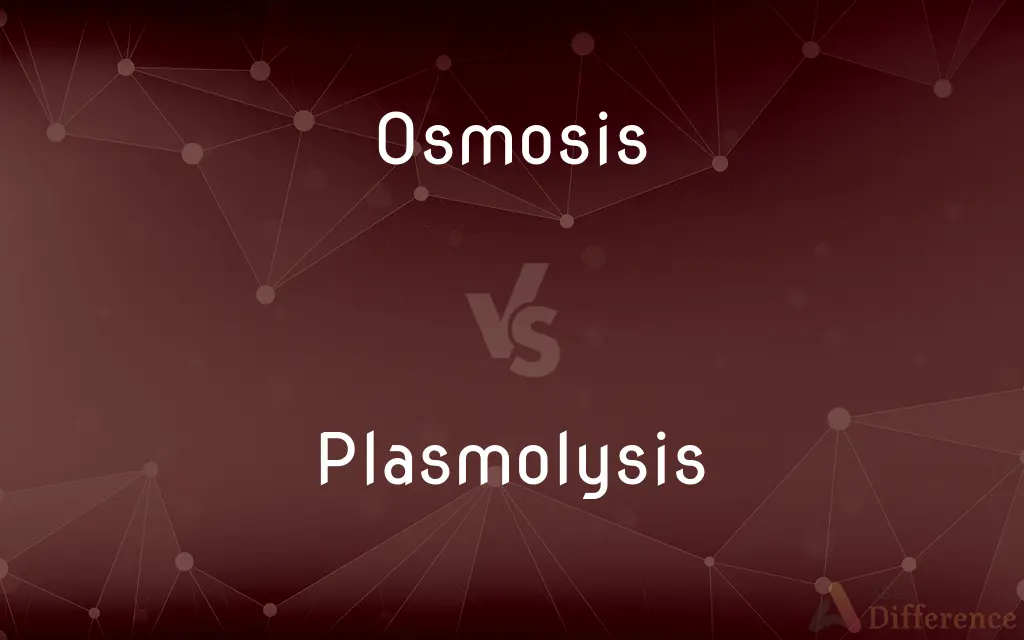Osmosis vs. Plasmolysis — What's the Difference?
Edited by Tayyaba Rehman — By Fiza Rafique — Updated on September 27, 2023
Osmosis is the movement of water across a semipermeable membrane due to concentration differences. Plasmolysis is the shrinking of a plant cell's cytoplasm due to water loss through osmosis.

Difference Between Osmosis and Plasmolysis
Table of Contents
ADVERTISEMENT
Key Differences
Osmosis and plasmolysis are related phenomena observed primarily in cellular biology. Osmosis refers to the passive movement of water molecules through a semipermeable membrane, usually in response to concentration gradients. On the other hand, plasmolysis occurs when plant cells lose water via osmosis, leading the cell membrane to pull away from the cell wall.
In the process of osmosis, water will move from an area of low solute concentration to an area of high solute concentration. Conversely, plasmolysis becomes evident when a plant cell is placed in a hypertonic solution, causing water to leave the cell via osmosis and leading to the cell's contraction.
Osmosis plays a crucial role in maintaining cellular hydration and nutrient balance. Without osmosis, cells wouldn't be able to regulate their internal environments effectively. Plasmolysis, in contrast, serves as a visual indicator of a cell's water status, revealing the effects of osmotic stress on plant cells.
Understanding both osmosis and plasmolysis is crucial for botanists and biologists alike. While osmosis provides insights into how cells manage water and nutrients, plasmolysis gives a direct view of what happens when plant cells are deprived of water through osmotic processes.
Comparison Chart
Definition
Movement of water across a semipermeable membrane
Shrinking of cell's cytoplasm due to water loss
ADVERTISEMENT
Caused By
Concentration differences
Water loss through osmosis
Results In
Equilibrium in water concentration
Cell membrane pulling away from the cell wall
Observed In
All cells
Plant cells
Role
Maintains cellular hydration and nutrient balance
Indicator of a cell's water status
Compare with Definitions
Osmosis
The passive movement of water across a semipermeable membrane.
Freshwater fish rely on osmosis to regulate their internal salt levels.
Plasmolysis
The contraction of the cell membrane from the cell wall in plants.
Plasmolysis can be visibly seen when onion cells are placed in a hypertonic solution.
Osmosis
The flow of solvent molecules through a selectively permeable barrier.
Osmosis plays a crucial role in plant root water uptake.
Plasmolysis
The state of a dehydrated plant cell due to external solute concentration.
Plasmolysis in guard cells results in the closure of stomata, reducing transpiration.
Osmosis
The equalization of water concentration across a membrane.
Dehydration disrupts osmosis, leading to cellular dysfunction.
Plasmolysis
The process where a plant cell's cytoplasm shrinks due to water loss.
When exposed to saltwater, plant cells undergo plasmolysis.
Osmosis
A biological process governing water movement in cells.
In reverse osmosis, water is purified by forcing it against concentration gradients.
Plasmolysis
A cellular phenomenon indicating osmotic stress in plants.
In lab experiments, plasmolysis is often demonstrated using salt solutions.
Osmosis
Osmosis (, US also ) is the spontaneous net movement or diffusion of solvent molecules through a selectively permeable membrane from a region of high water potential (region of lower solute concentration) to a region of low water potential (region of higher solute concentration), in the direction that tends to equalize the solute concentrations on the two sides. It may also be used to describe a physical process in which any solvent moves across a selectively permeable membrane (permeable to the solvent, but not the solute) separating two solutions of different concentrations.
Plasmolysis
The result of osmotic water loss in plant cells.
Prolonged drought can cause plasmolysis in many terrestrial plants.
Osmosis
Diffusion of fluid through a semipermeable membrane from a solution with a low solute concentration to a solution with a higher solute concentration. Osmosis ceases when there is an equal solute concentration on both sides of the membrane.
Plasmolysis
Plasmolysis is the process in which cells lose water in a hypertonic solution. The reverse process, deplasmolysis or cytolysis, can occur if the cell is in a hypotonic solution resulting in a lower external osmotic pressure and a net flow of water into the cell.
Osmosis
The tendency of fluids to diffuse in such a manner.
Plasmolysis
Shrinkage or contraction of the protoplasm away from the wall of a living plant or bacterial cell, caused by loss of water through osmosis.
Osmosis
A gradual, often unconscious process of assimilation or absorption
Learned French by osmosis while residing in Paris for 15 years.
Plasmolysis
(biology) the shrinking of protoplasm away from the cell wall of a plant or bacterium due to water loss
Osmosis
(chemistry) The net movement of solvent molecules, usually water, from a region of lower solute concentration to a region of higher solute concentration through a partially permeable membrane.
Osmosis
(figurative) Passive absorption or impartation of information, habits, etc.; the act of teaching or picking up knowledge incidentally, without actually seeking that particular knowledge.
I was reading about chickens, and I guess I learned about hawks through osmosis.
Osmosis
The tendency in fluids to mix, or become equably diffused, when in contact. It was first observed between fluids of differing densities, and as taking place through a membrane or an intervening porous structure. An older term for the phenomenon was Osmose.
Osmosis
Diffusion of molecules through a semipermeable membrane from a place of higher concentration to a place of lower concentration until the concentration on both sides is equal
Osmosis
The diffusion of water due to concentration differences.
Osmosis ensures that cells maintain an optimal water balance.
Common Curiosities
How is osmosis essential to cells?
Osmosis helps maintain cellular hydration and balances nutrients, ensuring cells function optimally.
Is osmosis exclusive to water?
While osmosis typically refers to water, the concept applies to any solvent moving across a semipermeable membrane.
What triggers plasmolysis in plant cells?
Plasmolysis is triggered when plant cells are in a hypertonic solution, leading to water loss.
Do animal cells experience osmosis?
Yes, animal cells, like all cells, regulate their internal environment through osmosis.
How do plants use osmosis in their roots?
Osmosis drives water uptake in plant roots as water moves from the soil to the roots due to concentration differences.
How does osmosis impact blood cells?
Osmosis can cause blood cells to swell or shrink, depending on the surrounding solution's tonicity.
How can one visually detect plasmolysis?
Plasmolysis is evident when the plant cell membrane contracts and detaches from the cell wall.
What is osmosis?
Osmosis is the passive movement of water across a semipermeable membrane due to concentration differences.
What does plasmolysis refer to?
Plasmolysis refers to the shrinking of a plant cell's cytoplasm due to water loss through osmosis.
Can plasmolysis occur in animal cells?
While the concept is similar, animal cells don't undergo plasmolysis but can lyse or crenate due to osmotic imbalances.
Can plasmolysis be reversed?
Yes, plasmolysis can be reversed by placing cells in a hypotonic solution, causing water to re-enter the cells.
Is plasmolysis harmful to plants?
Prolonged plasmolysis can be detrimental, affecting the plant's metabolic activities and overall health.
Why might a plant wilt due to plasmolysis?
Plants may wilt because plasmolysis reduces their cells' turgor pressure, leading to a droopy appearance.
Can osmosis occur without a membrane?
Osmosis specifically requires a semipermeable membrane to facilitate selective movement based on concentration differences.
How does reverse osmosis differ from osmosis?
Reverse osmosis forces water against its concentration gradient using pressure, purifying it.
Share Your Discovery

Previous Comparison
Conversation vs. Argument
Next Comparison
Irish vs. CelticAuthor Spotlight
Written by
Fiza RafiqueFiza Rafique is a skilled content writer at AskDifference.com, where she meticulously refines and enhances written pieces. Drawing from her vast editorial expertise, Fiza ensures clarity, accuracy, and precision in every article. Passionate about language, she continually seeks to elevate the quality of content for readers worldwide.
Edited by
Tayyaba RehmanTayyaba Rehman is a distinguished writer, currently serving as a primary contributor to askdifference.com. As a researcher in semantics and etymology, Tayyaba's passion for the complexity of languages and their distinctions has found a perfect home on the platform. Tayyaba delves into the intricacies of language, distinguishing between commonly confused words and phrases, thereby providing clarity for readers worldwide.
















































